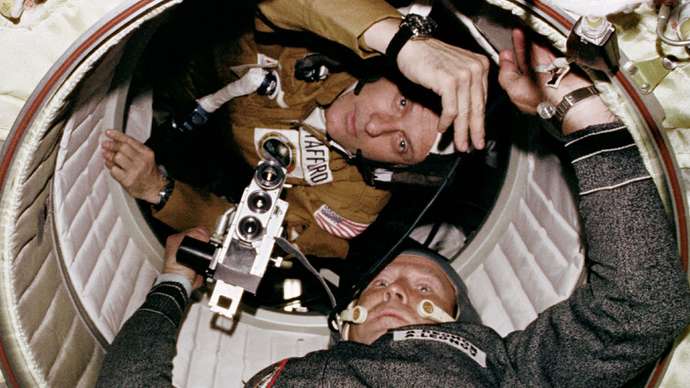Thomas P. Stafford and Aleksey Leonov during the Apollo-Soyuz mission, July 17, 1975. Image credit: NASA
Apollo, [this is] Houston. I’ve got 2 messages for you.
Moscow is GO for docking. Houston is GO for docking
It’s up to you guys. Have fun!
On July 17th 1975, two men exchanged a warm handshake.
So what, you may ask?
Nothing, except that particular handshake occurred 138 miles (222 kilometers) above the Atlantic, and the two men – an American and a Russian – were the commanders of two spaceships that had just rendezvoused while orbiting the Earth.
That was the Apollo-Soyuz mission!
It took three years of planning for the historic event to happen. During that time there were political challenges to overcome (at the time the United Stated and the Soviet Union were caught in a conflict known as the Cold War) and communication barriers to break (before the crew members began to train for the mission, none of them spoke each other’s language). The mission’s technical difficulties were something else entirely. A special docking module had to be developed to fit Soyuz hatch on one end and Apollo hatch – on another. And different ‘atmospheres’ of the two spacecraft (i.e. different oxygen mixtures pressurized at different levels in the cabins of Soyuz and Apollo) complicated the matter even further.
Luckily, politicians, engineers and the astronauts/ cosmonauts themselves were up to the challenge!
APOLLO-SOYUZ MISSION OVERVIEW
The Soyuz was successfully launched from Baikonur Spaceport in Kazakhstan on July 15th, 1975, at 7:20 am*. Exactly 7.5 hours later – at 2:50 pm – the US spacecraft took off from Kennedy Space Center in Florida.
*all times in this post are Houston time (i.e. Central Daylight Time); during the mission both countries actually used Greenwich GMT time to avoid any confusion
On board the Soviet craft were two cosmonauts, Alexei Leonov and Valery Kurbasov, both veterans of space flight. During Alexei Leonov’s previous space mission, Voskhod 2, he became the first man to walk in space. Valery Kubasov’s first spaceflight was Soyuz 6, when he performed the first welding in space. He would later fly on another mission, Soyuz 36.
American Apollo spacecraft carried the crew of three. Thomas P. Stafford (commander) had previously flown on two Gemini missions and commanded Apollo 10. For his crewmates Deke Slayton and Vance D. Brand Apollo-Soyuz was the first space mission. Brand would later fly 3 Shuttle missions, while Slayton would never cross the Karman line again.
After 2 days of careful boosting and ‘circularizing’ the orbits, the two spacecraft lined up in a rendezvous-ready position. Soyuz and Apollo successfully docked on July 17th at 11:10 am. At 2:17 the hatch was open and astronauts and cosmonauts exchanged warm greetings.
What followed was two busy days – 44 hours to be precise – filled with exploring each other’s spacecraft, performing experiments, sharing food and even sketching!
The joint experiments the Apollo-Soyuz crew performed include
- Observation of extreme ultraviolet sources outside the Solar System
- Taking pictures of the Solar Corona – the spacemen used Apollo module to create an ‘eclipse’ and block the central parts of the Sun
- Measuring density of the atmosphere at the spacecraft’s altitude
- Melting and solidifying samples of aluminum and some other materials in zero-g
The three astronauts and two cosmonauts shook hands once again – on July 19th at 10:17 pm before saying their final farewell and closing the hatch. The two spaceships stayed in orbit for several more days before making their- separate – ways home.
BACK TO EARTH
The return journey and landing of Soyuz was trouble-free, but Apollo experienced technical difficulties that nearly resulted in a tragedy.
At reentry, due to a human error, the rocket’s toxic fumes of nitrogen tetroxide gas entered the cabin poisoning the crew. One of the astronauts, Vance Brand, briefly lost consciousness. All three were hospitalized for several weeks, but made full recovery.
All in all, Apollo-Soyuz was a success, in technical, but maybe even more importantly, political sense.
The mission did not really end the cold war. Not even the space race. But it marked the beginning of the conflict’s end and opened doors for future dialogue and international cooperation.
DID YOU KNOW
While the English-speaking word knows the mission as Apollo-Soyuz, in Russia it is called Союз-Аполлон, i.e. Soyuz-Apollo!
MORE INFORMATION
Visit WonderDome Inflatable Planetarium to learn more about space and space exploration! Any questions? Comments? Let our Star Dome know in the comments below! We would love to hear from you!

